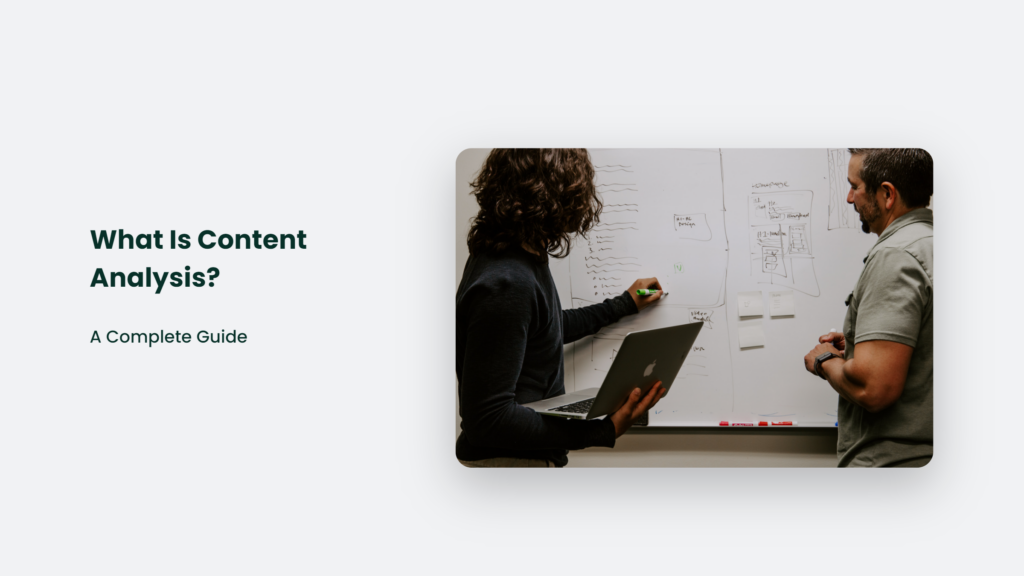

What Is Content Analysis? A Complete Guide

As Seen On
Have you ever wondered how researchers make sense of qualitative data like text, images, audio or video? Content analysis is one of the main methods used for systematically analyzing this type of information.
As online content and data continue to grow exponentially, content analysis is becoming an increasingly useful tool across many industries. Whether it’s academics analyzing social media trends, marketing managers reviewing customer feedback, or HR professionals evaluating workplace culture, content analysis is hugely valuable.
So, what is content analysis? And how can you apply it in real-world situations? Let’s find out…

What is Content Analysis?
Content analysis is a research method used to identify patterns and themes within qualitative data like text, images, audio or video. Researchers systematically code and classify the data, allowing them to make inferences about the messages, writer, audience or culture that created it.
Some key features of content analysis include:
- Analyzing communications and making inferences from them
- Taking qualitative data and transforming it into quantitative data
- Providing insights into complex human perceptions and interactions
I don’t know about you, but that still seems pretty complex. So let’s break it down step-by-step…
Step 1: Develop Research Questions
You need to nail down your research question(s) first.
It gives your analysis focus and direction.
Some examples could be:
How do young people perceive vaping based on social media content?
- What workplace values are most frequently referenced in our company culture manual?
- Is media coverage of the new tax policy mostly positive or negative?
Spend time developing clear, specific research questions to frame your objectives from the start.
Step 2: Select Your Sample
Next, you need to determine what sample you’ll analyze. It could include:
Social media posts
- News articles
- Historical documents
- Interview transcripts
- Company reports
- Video Footage
Select a sample that’s directly relevant to your research questions. For example, analyzing Reddit threads to understand Gen Z’s vaping perceptions.
Your sample size can range from a couple of hundred social media posts to thousands of news reports or images. The key is choosing a sample that addresses your specific research aims.
Step 3: Develop a Coding Scheme
Here comes the fun part – developing your coding scheme! It categorizes your data to identify key patterns and themes.
First, you familiarize yourself with the sample, making notes on emerging topics, sentiments, phrases, etc. Next, you develop a coding scheme to classify these elements. For example:
- Positive, negative or neutral sentiment
- References to specific issues like health, addiction, cost
- Mentions of personal experiences
The coding scheme must tie directly to your research questions. It turns qualitative data into quantitative metrics you can analyze.
Pro tip: Involve multiple coders and calculate inter-coder reliability to ensure consistency.
Step 4: Code the Data
It’s time to apply your coding scheme to the sample methodically. You read through the content, classifying each relevant passage according to your defined categories.
It transforms subjective qualitative data into objective metrics and numbers – enabling in-depth analysis.
For example, you may find that 58% of social media content expresses negative sentiment about vaping. Powerful discoveries!
Step 5: Analyze and Interpret
The fun really starts once your coding is complete. Now, you get to analyze the results and interpret their significance.
By crunching the numbers, you can objectively see which themes occur most frequently, which sentiments are dominant, which are the differences across periods and data sources, etc.
In the analysis stage, you turn surface-level observations into deeper insights and conclusions that answer your research questions. It allows you to make theoretical connections and practical recommendations.
For instance, you may conclude that more education is needed to balance teens’ perceptions of vaping risks and benefits. Content analysis transforms raw data into impactful findings.
Benefits of Using Content Analysis in Research:
Here are some of the key benefits of using content analysis in research:
- Provides insights into complex human perceptions and interactions by systematically analyzing communications
- Allows both qualitative and quantitative analysis, giving a mix of interpretive depth and statistical overview
- Can analyze diverse data from various sources like social media, news, ads, etc. to identify trends over time
- It an unobtrusive technique that doesn’t require direct participant involvement so it avoids ethical issues
- Relatively inexpensive and accessible compared to other research methods
- Reproducible method that generates reliable, valid results when performed correctly
- Valuable for documenting historical/cultural insights by analyzing texts longitudinally
- Data can be statistically analyzed to make inferences and draw conclusions
- Provides closeness to textual data and simplifies detecting patterns
- Flexible method applicable across a wide range of fields from marketing to sociology
Real-World Content Analysis Examples
Hopefully, the process is now clearer. But nothing beats some real-world examples highlighting content analysis in action…
Social Media Monitoring
Content analysis is hugely valuable for social listening. Brands use it to identify key themes and sentiments within social conversations about them.
For example, Wendy’s analyzed tweets mentioning their brand. They classified each tweet as positive, negative or neutral. It revealed that 86% had a positive sentiment, indicating widespread brand love!
News Framing
Researchers often use content analysis to evaluate media framing biases.
For instance, an analysis of New York Times articles found language frequently framed immigration issues using metaphors like “floods” of immigrants or an “invasion” of foreigners. This dehumanizing rhetoric has shaped the public debate.
Advertising Trends
Content analysis also helps identify trends in representation across mediums like advertising.
Studies have analyzed how gender stereotypes are portrayed on primetime TV. Or racial diversity in Super Bowl commercials. It highlights how media evolves – or occasionally doesn’t!
Why Content Analysis is Vital Today
In our digital age, content grows exponentially across all platforms and mediums. Unstructured qualitative data is flooding the internet – from social media posts to customer reviews.
It presents an amazing (and overwhelming!) treasure trove of insights. But only if you can accurately organize and analyze it.
Content analysis allows you to unlock these insights systematically and scientifically. It serves up revelations on consumer perceptions, cultural trends, human interactions, and so much more.No wonder it’s becoming one of the most popular and powerful research tools across diverse industries like:
- Academia
- Government
- Public Relations
- Marketing
- Business Strategy
- Media Monitoring
- Advertising
- Political Campaigning
And as content proliferates across digital channels, so does the value of content analysis. It’s never been more important to mine insights from the data deluge accurately.
Frequently Asked Questions:
What are the main advantages of content analysis?
Benefits include providing rich insights into complex qualitative data, allowing both qualitative and quantitative analysis, being cost-effective and unobtrusive, and simplifying pattern detection.
How do you analyze and interpret the results?
Look at the frequency of codes, sentiment breakdowns, differences across time periods or sources, etc. Then, make connections to draw conclusions that provide deeper meaning and address your research aims.
Let the Analysis Begin!
So there you have it – a complete step-by-step overview of content analysis and how it works.
It’s a handy way to identify key patterns and extract insights from qualitative data. It allows you to make evidence-based decisions that resonate with your audiences.
The process does take time and skill. However, the DIY steps above should give you a framework for conducting your content analysis studies.
Review some content samples, create a coding scheme, and start unlocking those golden insights! It could reveal game-changing revelations about your customers, brand, competition or wider culture.
Have you used content analysis in your business or research? I’d love to hear your experiences in the comments below! Let me know what worked well or any challenges you faced.
Konger
Up until working with Casey, we had only had poor to mediocre experiences outsourcing work to agencies. Casey & the team at CJ&CO are the exception to the rule.
Communication was beyond great, his understanding of our vision was phenomenal, and instead of needing babysitting like the other agencies we worked with, he was not only completely dependable but also gave us sound suggestions on how to get better results, at the risk of us not needing him for the initial job we requested (absolute gem).
This has truly been the first time we worked with someone outside of our business that quickly grasped our vision, and that I could completely forget about and would still deliver above expectations.
I honestly can't wait to work in many more projects together!
Disclaimer
*The information this blog provides is for general informational purposes only and is not intended as financial or professional advice. The information may not reflect current developments and may be changed or updated without notice. Any opinions expressed on this blog are the author’s own and do not necessarily reflect the views of the author’s employer or any other organization. You should not act or rely on any information contained in this blog without first seeking the advice of a professional. No representation or warranty, express or implied, is made as to the accuracy or completeness of the information contained in this blog. The author and affiliated parties assume no liability for any errors or omissions.
